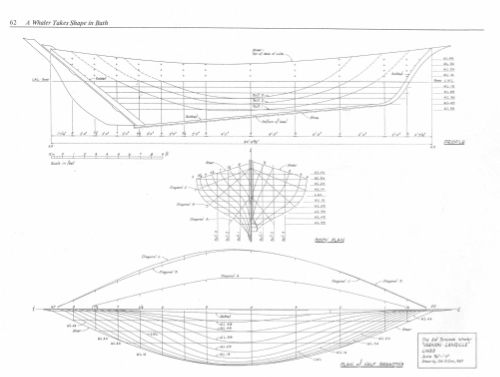I recently had the pleasure of sailing the double-ended, gaff-rigged schooner, Jack O'Lantern, owned by Bruce Barnes, of Taos New Mexico. Bruce acquired this boat from builder Charlie Taylor, in a partially complete state and spent the last few years in Port Townsend, Washington, fitting the boat out. The day I crewed on Jack O'Lantern was the first time she had been under sail since her build began, back in 1975.

Jack O'Lantern is a fifty foot Tancook Whaler, so called, though they did no whaling, a fishing boat hailing from Tancook Island, Nova Scotia. She is an adaptation of a fine design, more than a little out of the ordinary, which evolved to its peak, in the mouth of Mahone Bay, Nova Scotia, around the middle of the 19th century.
The whalers probably rose from a long-standing double-ender tradition traceable to European craft including the Dutch pinques, the French chaloupes and the shallops of the English and the Basques. Translated to the New World, these ancestors evolved into the Chebacco boats, Cowhorns, and later Nomans Land boats, Isle au Shoals, Hampton whalers, pinkys, Quoddy boats, and the Gaspe (Canada) boats or pinques.
The small open boats of the North American fisheries evolved from the laws of usage and adapted to the regional demands and the type of fishery. Since whaling was an early fishery and continued well into the 19th century on that coast, it seems likely that whaleboats of varying designs had their part in the development of the Tancook.
"Shortly, through the fog, appeared brown sails (their sails were nearly always tanned) and a white hull, between 40 and 50 feet long. The boat seemed to approach slowly, to hesitate a moment, and then to leap past in the manner of boats passing at sea... But there was time to observe two or three men in yellow oilskins, the helmsman standing with the end of the great ten-foot tiller behind his back, lifted slightly form the comb, and the load of barrels and boxes partly covered by a tarpaulin or, more likely, by the brown staysail (it was not set) in her waist… They were then close aboard. The tiller was swung a trifle to weather; the loose-footed overlapping foresail filled with an audible snap, and away she went, at eight or nine knots, her lee rail occasionally awash, and with a smoothness and lack of fuss in that broken water which, somehow, no other boat has ever seemed to me quite able to obtain – and I have known some good ones! … My friend remarked … “Damn good boats, them Tancook Whalers!”" ( Ernest Bell, Yachting, February, 1933)

Obviously Charlie Taylor has taken liberties in adapting the open Tancook Whaler into a closed cabin yacht. Jack O'Lantern, though she has a deep ballasted keel, coupled with a heavy plate centerboard, has a good bit of top-hamper and could use more ballast. In the accompanying photos, taken during the Port Townsend Wooden Boat Festival, she has taken down her foresail and may still be over-canvased.
And here's the clincher: Jack O'Lantern is for sale. You all know how much Doryman loves a project...
LOA: 60 feet
LOD: 50 feet
Beam: 12 feet






2 comments:
Michael,
You may know the name Ralph Wiley. He designed a number of Tancook Whaler inspired cutter/ sloops on the Chesapeake back in the late 40/50s. A couple were raced against hot shot sailors in Annapolis and won on numerous occasions.
Neat tale there. Thanks-
E
Eddie,
I assume the boats Ralph designed were open versions. The cabin on Jack O'Lantern is luxurious, but I have to admit, I like the look of the open boats better.
Post a Comment